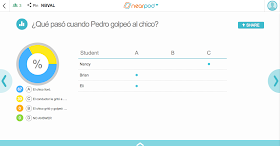Lately, I've been having fun exploring the uses of Nearpod to present the target language in context in a way that engages all students.
What is Nearpod? It is an ipad slide sharing app that enables the teacher to control which slide the students are viewing on their ipads. You can create a new presentation or upload a powerpoint presentation you have on file onto the Nearpod site. The teacher views the presentation from her account on Nearpod as the students view the same presentation on ipads or ipods.
Nearpod goes beyond being a simple powerpoint presentation. There are options to embed quizzes, polls, sketches, matching activities, fill in the blanks, add voice, etc. As the students answer and complete the activities, the teacher can view their answers in real time on her computer screen. Also, there is the ability for the teacher to share the students' answers anonymously with the class. By clicking "share", one student's answer will appear on all the ipad screens.
Below is an explanation and example of one of the Nearpod presentations I created and used with my Spanish 2 classes.
My focus structures were: se durmió, se despertó, and estaba cansado. I wrote a story with a plot that provided opportunities to repeat those structures throughout the story. You can write text directly on the Nearpod slides, but it was too limiting to me, so I wrote the text on a powerpoint slide and uploaded it as an image. I looked for places in the text where I could check for students' comprehension, and places where I wanted the students to add their ideas to the story. Then I added slides in the Nearpod presentation with comprehension questions, polls, questions that required the students to sketch, and a fill in the blank activity to summarize.with questions and polls. I drew some sketches to accompany the story and added the sketches to several of the activity pages on Nearpod.
The title of the story is Pedro se durmió. Below is a screenshot of the first part of my presentation as it appears on my Nearpod account.
To start the presentation, each student had an ipad and I gave them the 5 letter code to enter the Nearpod presentation. As they entered, my screen showed the names of the students. It also showed the number of students that entered the presentation in the top right corner. (If at any time a student leaves the Nearpod presentation to explore the internet, the number changes from green to red to alert the teacher that a student has left the session. The teacher can then click on the icon and see which student is not on task.)
After the students were in the session, the picture of Pedro and the title appeared on their screen. Then I moved to the first slide with text and I told them about Pedro. I used the circling technique to familiarize the students with Pedro's information, along with personalized questions about the students' ages, if they ever went to San Antonio, etc.
Then I swiped to the next slide, which moved the presentation to the next slide on each of the students' ipad screens. This slide had 4 short comprehension questions for them to answer. As they submitted their answers, I quickly saw which students needed more circling and repetitions of the information. Below is a screenshot of an example of what the teacher sees as the students answer. (I took this screenshot for this post, not during the actual presentation with the students.)

The next slide had additional text, followed by a slide that asked students why Pedro was so tired. They typed in their answers and I watched the answers appear on my screen. I told the class about 3 of the options the students had written and I wrote the sentences on the board rather than share the students' screens. (This is a Spanish 2 class and since there were small errors in the answers, I didn't want the students seeing the errors.) I then wanted the students to choose which option they wanted to be part of the story so on the following slide they could choose a, b, or c. Their answers appeared on my screen, and the answer with the highest votes became part of our story.
Below is a screenshot of what the teacher sees when the class completes a poll. (This particular poll below, actually is later in the story.)
I continued the storytelling by reading the text with the students, asking comprehension questions while they had the text on their screens, and asking more personalized questions.
In one part of the story, the students had to sketch what Pedro's two friends did when they saw that he was sleeping. The picture to the right is an example of what a student could draw on their ipad. (I actually drew it to create this blog post). After the students had submitted their work, I was able to view ALL of their sketches and then anonymously shared the student sketches with the students. It provided me material for a LOT of repetitions of verbs in the 3rd person plural.
Below is the teacher's screen that shows 3 student sketches. The teacher can choose all or only a few of the sketches to share with the class to discuss.
On the very last slide, I created a fill in the blank activity. Since I wanted the students to read, yet one more time, the target structures, I DID NOT choose those words for the students to fill in the blanks. I chose words close to the target structures so the students had to read the target structures in order to figure out which word in the word bank at the bottom of the page was the best choice.
The following day in class, we reviewed the story that the class had helped me to create. Then I distributed a copy of my original story and we read it together. For an additional reading, I had the students form a diagonal line from one corner of the classroom to another. They paired up with another student and their task was to read the story in English. When I told students to change, one student had to move to the right, and the person at the end of the line went to the front of the line. Students continued reading with their new partner. While they were busy doing that, I placed a paper with questions related to the reading on their desks. I sent them to their desks to complete the questions. After all of the readings and work with the text the previous day, the comprehension and short answer questions were a cinch for the students to complete.
I used the Pedro se durmió story with two classes. After we finished, I asked for student feedback. They said they enjoyed helping to create the story with Nearpod.
Advantages of using Nearpod in connection with storyasking/storytelling:
- All students participated
- Instant feedback on which students understood the story and which students needed additional circling and repetition. I didn't have to specifically call on students to find this out since ALL answered the comprehension questions.
- It is easy to return to earlier slides when more repetition is needed.
- Students really wanted to see ALL their classmates' sketches. This meant they heard a LOT of examples of verbs in the 3rd person plural.
- It kept the students actively engaged. There was not much time for them to "zone out".
- Quiet students were engaged.
- I liked the ability to share answers anonymously. If I wanted to share a sentence that was incorrect, I could ask students what they would do differently, but none of the students would know who had written the sentence that was being shared.
Disadvantages to Nearpod
- I STILL...haven't been able to receive help from the Nearpod staff on why I am unable to share the presentation. (frustrating) Update: I found a way to share the interactive presentation that is on my Nearpod account. If you want to view it and have a copy of it, send me your email (in comments below or a direct message through Twitter if you don't want to make your email public) and I will email it to you. You need a basic free account with Nearpod in order to access the presentation.OR...try the following link (you must have a basic nearpod account to open it).
open this link.
- It takes more time to prepare for a story than regular storytelling.
- We are not a 1:1 school, so I need to plan ahead to ensure that I have access to the ipads on a particular day.
- There is a limit to how many presentationsyou can save to the Nearpod account. If you have the free basic level (silver level), only 30 students can log into Nearpod at one time.
- You need an internet connection.
- Technology, overall, diminishes that one-to-one interaction.
Overall, I liked trying something new for storyasking/storytelling. I will
probably use Nearpod for this type of activity 2- 3x/semester (1 semester = 90 days). I don't want to overuse it or the novelty will wear off quickly.
 |
| Another story uploaded to Nearpod |
If you want to see the full presentation/story, click HERE to see the presentation that I uploaded to my GoogleDrive. (It isn't interactive because it is a powerpoint of the Nearpod presentation.) I took screenshots from the student's view and from my desktop view for the presentation and then added those screenshots onto a powerpoint. It would be much easier to share if/when Nearpod figures out why my Sharing is not functioning in my account.
I have another Nearpod storytelling presentation that I used with another class on "Larry el vampiro". If Nearpod can correct the issue with sharing, I'm willing to share that one through the app email with anyone that is interested.
The above is an example for storyasking/storytelling. Nearpod has MANY other uses which I am interested in seeing and hearing how other MFL teachers have incorporated it into their classes.

























